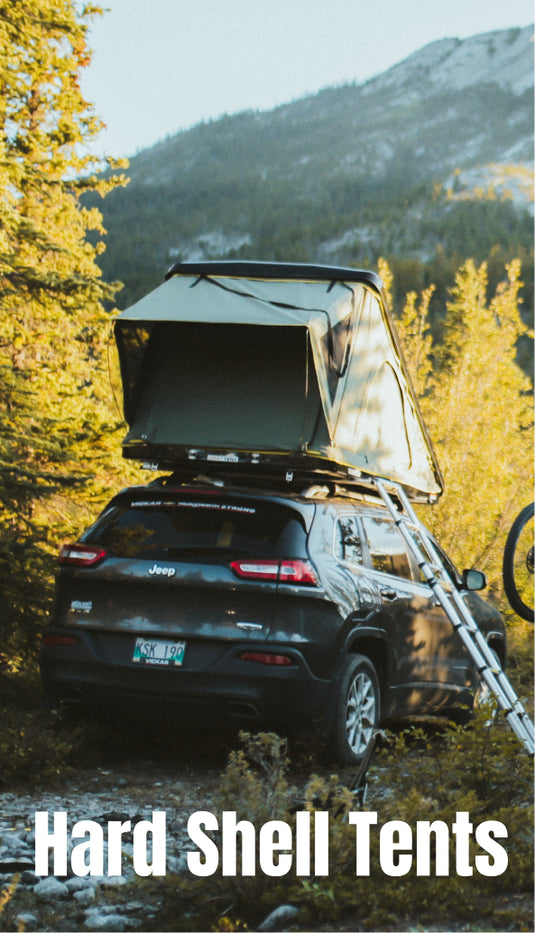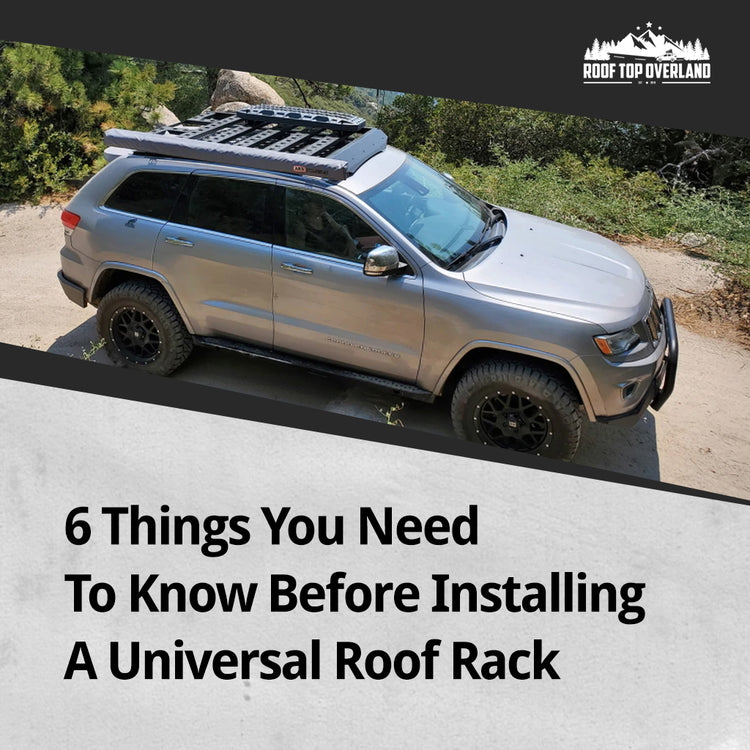If you are planning an Overlanding adventure, a camping trip, or even a family holiday, chances are you are thinking of getting some roof racks. Unless you are specific about things, universal roof racks are the way to go. But, there are a few things to take into account before you buy a set. It is important to note that while the racks are universal, the fittings connecting the roof racks to the car are specific to vehicle type or model.
Picking the first set of roof racks you see and applying them to your vehicle is not ideal. There are many aspects to be considered when buying and installing universal roof racks on your car or truck. For example, you will need to consider the type of rack system that fits your vehicle’s roof design. Also important is the weight capacity your car’s roof can withstand, and even whether roof racks are legal. Below, you will find a comprehensive list of the most important aspects to consider before installing a universal roof rack.
Understanding Universal Roof Racks
Are Roof Racks Illegal?
The first, and one of the most important questions to ask yourself before purchasing a set of roof racks is, are they illegal? If you are planning to travel into a different state or even across the country, you will need to find out the state laws on roof racks and loading. Each state has a set of unique rules that, if not followed, could earn you a hefty fine.
While roof racks themselves are legal throughout the US, each state has its own set of traffic laws. As an example, West Virginia allows for a vehicle to be equipped with roof rack lights on condition that the light is not operated on any road or highway within the state. In comparison, California allows you to have a light bar; but, you must keep it covered at all times. There are only 16 states with laws on improper loads in the US, but it is still essential to be aware of the limitations and regulations. However, across all 50 states, it is against the law to have something drop or fall from your vehicle. This could result in a fine or even jail time - so make sure you secure the items to your roof firmly each time you travel.
What Roof Racks Will Fit My Car?

You need to know what roof system your vehicle has before purchasing a set of roof racks. Why? Because different vehicle makes and models come with their own roof design. This means unique installment methods and fittings are needed to attach roof racks to your car. The owner’s manual that comes with your vehicle will tell you what roof system your vehicle has. The manual will also reference what roof rack systems will work with your car. Alternatively, you can take a look at your vehicle’s roof and see what roof rack system you will need. The roofing systems and roof rack styles to match are as follows:
- Bare or Naked Roof Systems
These are car roofs with no means for attaching roof racks such as rails, rain gutters, or fixed mounting points. Here you will use clamp-on crossbars or bolt a roof rack system to your car by drilling holes into the roof’s body. An example of this would be a Ford Ranger overland rack.
- Fixed Point Systems
These roof systems come with four factory-installed fixed-points. It is to these points that you attach your roof racks. Caps or the weather-trim often cover the points. Roof rack systems come with crossbars that mount to these fixed points. The Toyota Tacoma Cab Rack makes use of this system.
- Rain Gutter Systems
This roof style sees a rain gutter that runs along the edge of the roof. The style is most often found in vehicles such as Jeeps, making the Jeep overland roof rack the perfect example. These systems need roof racks that come with unique feet and clamps the slide into the rain gutters and fasten onto them. This style of roof system is outdated and not found frequently in cars these days.
- Raised Rails
These vehicles come with pre-installed roof rails that work like roof racks themselves. Crossbars with unique feet that clamp to these raised rails. Another Jeep roof rack makes the perfect example here, this time for the Jeep Grand Cherokee.
What is The Capacity of My Car?

Car capacity is an all-important question you need to answer. The user or owner’s manual of your vehicle will indicate the degree of the load your car can carry. If you don’t have the owner’s manual, you can always call a dealership for the information or look it up on the internet. It is essential to note this because not only can overloading your vehicle leave you with a hefty fine, it also increases your risk of having an accident.
Understanding the dynamic capacity, that is, the load your car can carry on the roof while traveling down the street, is crucial. Most cars, trucks, and SUVs can only carry up to 165-pounds on average. A Toyota Rav 4, for example, only offers a capacity of 100-pounds. Each vehicle’s capacity differs, making it essential to find out your car’s dynamic capacity. Even if a larger capacity fits into your roof box, it does not mean you should go over the prescribed weight limit.
However, it would help if you did not fall into the trap of confusing dynamic capacity with static capacity. Static capacity is the load weight the vehicle can hold while standing still. This number is often higher than that of the dynamic capacity. When loading up your car, it is the dynamic capacity you adhere to. Why? The greater your load, the greater your vehicle’s force when it is in motion. This means, when coming to a stop, your brakes need to work harder, increasing the amount of time it takes you to slow down. Overloaded vehicles may experience brake failure. Overloading may also mean you cannot stop in time at a traffic light or when you need to stop quickly in the event someone pulls out in front of you. This leads to severe accidents. When you overload a vehicle, you may also experience issues in handling. Vehicles come with their weight evenly distributed and close to the ground. This allows the vehicle to turn corners at speed without toppling over. When your load is placed on the vehicle’s roof, it throws off the car’s center of gravity. Transferring the bulk of the weight to the top of the vehicle when you overload it means your vehicle loses its ability to handle corners. As a result, your vehicle may overturn.
What Size Roof Racks Do I Need?

Roof racks come in an assortment of sizes; knowing which size to get will depend on your vehicle. Acquiring the correct size roof racks is of importance for many reasons. Most states have traffic laws regarding the overhang allowed. Your roof racks must not extend past a certain distance from your car roof; if they do, you will incur a fine. Another point is that roof racks that are too long may prevent your vehicle from fitting in your garage. Overextended roof racks will also impact the aerodynamics of your car, causing drag that increases fuel consumption. Your vehicle’s handling will also be affected.
What accessories will I need, and what accessories work with my roof racks?
Knowing which accessories you will want to use with your roof racks will also determine the size and style of roof racks you end up getting. The width of the crossbar determines the number of accessories you can add to your roof rack system. Some of the overland accessories you can find are cargo boxes, bicycle racks, kayak holds, and even rooftop tents.
What maintenance will my roof racks need?
Roof racks require maintenance. One of the essential aspects of care is checking to see that the roof racks are firmly in place. We advise checking the stability after every 1000 km traveled. Do this by giving them a firm shake in each direction to see if they need tightening. If you don’t park your car in a garage, it may be a good idea to remove the roof racks when they are not in use. This will extend the longevity of your roof racks. Remember, if you take your vehicle to be cleaned at the car wash, always remove your roof racks first, if they are the type of roof racks that can be removed.
In Conclusion
Knowing what is what when it comes to roof racks is essential for multiple reasons. Understanding your vehicle, the roof racks it supports, and its dynamic capacity will keep you safe on your travels. This knowledge will also save you from a hefty fine. Knowing which roof system your car has will save you money and time. How? By preventing you from buying roof racks that won’t fit or work with your car’s roof design. Maintenance will ensure the best fit and keep your roof rack system in tip-top condition. And lastly, sizing and knowing what accessories you want to use will help you select the best set of roof racks to suit your needs. Now that you have considered each of these points, look at our exclusive range of roof racks to find your perfect set.

